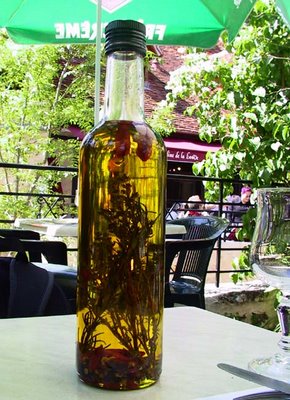On Sunday April 30 we drove from our gîte near Sarlat over to the town of Rocamadour in the Quercy (département du Lot). We went south through Gourdon and then on little back roads through a big regional park to the village of Couzou. There we turned north to enter Rocamadour from the opposite side of the Alzou river canyon, where you get some of the best views of the town.
The Cadogan guide called Dordogne & the Lot describes Rocamadour as a "medieval French version of a Pueblo village in North America, a vertical cliff-dwellers' town." And so it is. The river cuts a deep ravine through the landscape, and the town is a grouping of houses and buildings piled on top of each other on a cliff, topped by a château.
Rocamadour is named for a saint called Amadour -- this was his rock. No one knows exactly who he was or when he lived, but his intact corpse was found buried near the church in the village in 1166 A.D., according to legend. Some say he was a hermit of Egyptian origins. Others say he was a disciple of Christ who ended up living in this part of the world.
In the middle ages, Henry Plantagenet, king of England, came here to pray to the statue of the Virgin Mary in the church, as did many others. Rocamadour was a pilgrimage site for French kings and religious figures. The cult of Notre-Dame de Rocamadour spread to Spain and Portugal.
Rocamadour reached its apogee in the 13th century. During the 100 Years War, the English and assorted bandits sacked the place numerous times. Later, during the great wars of religion, protestants did the same. They tried to incinerate the still-intact body of Saint Amadour, but it wouldn't burn, legend says.
Rocamadour never really recovered from the ravages of the late middle ages. In the 19th century, the bishops of the nearby town of Cahors tried to relaunch the pilgrimages and restored the church and other buildings. They were fairly successful. But most of today's pilgrims go by another name — they are simply tourists.
The streets of old Rocamadour are lined with shops selling all kinds of souvenirs and postcards alongside local food specialities including foie gras and tins of confit de canard. There are plenty of restaurants, and because the town hangs off the side of a south-facing cliff, the outdoor tables are a warm and pleasant place to have lunch when the sun is shining.
You can walk from the streets below all the way up to the château to admire the fantastic views. Or you can take an elevator (2.50€ for a one-way ride, or 4.00€ for a round trip!). In olden days, pilgrims — often on their knees — would climb the 233 steps from street level up to the church, which was rebuilt in Gothic style in 1476 after a boulder fell and destroyed an older church on the site. In the church stands a famous Black Virgin — a 2-foot high statue of Mary with the Christ child carved out of walnut wood in the 12th century.
After a lot of climbing around, we (and hundreds of others) had lunch in one of the restaurants in the village. We sat outside and had a view out over the canyon. I had a steak (bavette- frites- salade) and Walt had a pizza. Our friend Sue had spaghettis à la carbonara. It was a most pleasant way to end our tour.











Ken,
ReplyDeleteThis is just so beautiful...and now I'm ashamed of myself because I've been in France for 20 years and never visited this wonderful place. It's going directly to the top of my list for 2007, thanks.
Emiy
Rocamadour est très pittoresque, mais un rien trop surfait quand les touristes l'envahissent... Un peu comme le Mont-Saint-Michel qui devient presque détestable quand la horde de touristes déferle... Vu au printemps, cela doit être beaucoup plus agréable :-) Je me souviens des marches..., usées par les genoux de tous ces pélerins...
ReplyDeleteEt Padirac ? Tu nous en parles demain ;-) ? Bises. Marie
Emily, there are several unforgettable towns and villages in the area around Rocamadour -- Turenne, Martel, St-Céré, Collonges-la-Rouge, and others -- so it really is worth the trip. I'll be posting more pictures.
ReplyDeleteKen
Marie, la photo était interdite à Padirac ! Mais tu parles d'un peuple ... on a fait la queue longuement et plusieurs fois pendant la visite. Tu attends pour payer, tu attends devant les portes des ascenseurs, tu attends de monter dans un petit bateau, et puis tu attends le guide pour la visite à pied. Rocamadour, en comparaison, était déserté. Même par un beau dimanche après-midi, il n'y avait pas trop la foule. Bises, Ken
ReplyDeleteSusan, I have to admit that we did not climb all the way to the top of Rocamadour. We drove up there, parked, and then walked out to take in the view. The day before we had struggled up a steep old path up to the top of the hill that the château de Beynac sits on. We were pooped. I'll post some pictures of Beynac this week. Ken
ReplyDelete